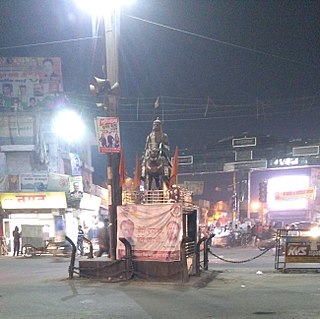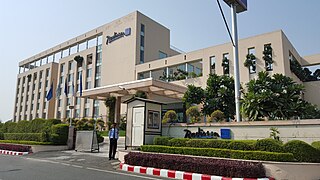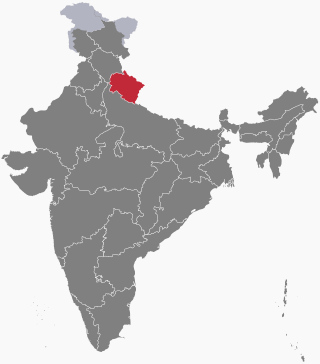
Dehradun, also known as Dehra Doon, is the winter capital and the most populous city of the Indian state of Uttarakhand. It is the administrative headquarters of the eponymous district and is governed by the Dehradun Municipal Corporation, with the Uttarakhand Legislative Assembly holding its winter sessions in the city as its winter capital. Part of the Garhwal region, and housing the headquarters of its Divisional Commissioner, Dehradun is one of the "Counter Magnets" of the National Capital Region (NCR) being developed as an alternative centre of growth to help ease the migration and population explosion in the Delhi metropolitan area and to establish a smart city in the Himalayas.

Haldwani is the largest city of Kumaon. It is also the fourth most populous city in the Indian state of Uttarakhand. Haldwani is said to be the financial capital of Uttarakhand, having the most commercial, economic and industrial activities of the state. Haldwani is located in the Nainital District, and is one of its thirteen Subdivisions. The Haldwani Urban agglomeration has 656,000 people as of 2021, and is the third most populous UA in Uttarakhand, after Dehradun and Haridwar. Being situated in the immediate foothills of Kumaon Himalayas, the Kathgodam neighbourhood of Haldwani is known as the "Gateway to Kumaon".

Roorkee is a city and a municipal corporation in the Haridwar district of the state of Uttarakhand, India. It is 31 km (19 mi) from Haridwar city, the district headquarter. It is spread over a flat terrain under Sivalik Hills of Himalayas. The city is developed on the banks of Ganges Canal, its dominant feature, which flows from north–south through middle of the city. Roorkee is home to Asia's first engineering college Indian Institute of Technology Roorkee, formerly known as Thomson College of Civil Engineering. Roorkee is also known for the Roorkee Cantonment, one of the country's oldest military establishments and the headquarters of Bengal Engineer Group since 1853. A freight train ran in between Roorkee and Piran Kaliyar on 22 December 1851, this was two years before first passenger trains were started between Bombay and Thana in 1853 and 14 years after first freight trains ran in Chennai in 1837.

Kashipur is a city of Udham Singh Nagar district in the Indian state of Uttarakhand, and one of its seven subdivisions. Located in the western part of Udham Singh Nagar district, it is Kumaun's third most populous city and the sixth most populous in Uttarakhand. According to the 2011 Census of India, the population is 121,623 for the city of Kashipur and 283,136 for Kashipur Tehsil. Kashipur also has IIM Kashipur, one of the thirteen Indian Institutes of Managements the government has set up during the Eleventh Five-year Plan.

Rudrapur is a city that serves as the headquarters of the Udham Singh Nagar district in the Indian state of Uttarakhand. Located at a distance of about 250 km (160 mi) northeast of New Delhi and 250 km (160 mi) south of Dehradun, Rudrapur is located in the fertile Terai plains in the southern part of Kumaon division over an area of 27.65 km2. With a population of 140,857 according to the 2011 census of India, it is the 5th most populous city of Uttarakhand.

In India, the Urban Local Bodies (ULBs), also called municipalities, are self-government institutions responsible for the administration of cities, towns, and transitional areas within a state or Union Territory. The 74th amendment to the Constitution of India in 1992 provided constitutional framework for the establishment of Urban Local Bodies.
A municipal corporation is a type of local government in India which administers urban areas with a population of more than one million. The growing population and urbanization of various Indian cities highlighted the need for a type of local governing body that could provide services such as healthcare, education, housing and transport by collecting property taxes and administering grants from the state government.
Local bodies in Tamil Nadu constitute the three tier administration set-up in the South Indian state of Tamil Nadu. It is a system of local government which forms the last level from the Centre. Chennai Corporation in the then Madras Presidency, established in 1688, is the oldest such local body not only in India but also in any commonwealth nations outside United Kingdom.

The Malappuram Metropolitan Area or Malappuram Urban Agglomeration is an urban agglomeration centred around the city of Malappuram, Manjeri in Malappuram district, Kerala, India. It is the 25th largest urban agglomeration in India and the 4th largest in Kerala.

The Dehradun Municipal Corporation is the civic or urban local body that governs the city of Dehradun in Uttarakhand, India. It is essentially the city government and differs from the MDDA, which is a state run organisation.

The following outline is provided as an overview of and topical guide to Uttarakhand:

Elections to the local bodies in Uttarakhand, India, are conducted once in five years to elect the representatives to the urban and rural local bodies. These elections are conducted by the Uttarakhand State Election Commission and were mandated by the 74th Constitutional Amendment Act to ensure local government in urban and rural areas.
The 2018 Dehradun Municipal Corporation election was a municipal election to the Dehradun Municipal Corporation which governs Dehradun City, the largest city in Uttarakhand. It took place on 18 November 2018.
Urban Development Directorate (UDD) is the administrative department in the state of Uttarakhand. It is an autonomous state government agency responsible for urban planning and development control. There are 92 Urban Local Bodies in the state of Uttarakhand i.e. 8 Municipal Corporations, 41 Municipal Councils and 43 Town Panchayats.
The 2018 Uttarakhand Municipal general elections were held in the Indian state of Uttarakhand on 18 November 2018.
The 2019 Uttarakhand Panchayat general elections were held in the Indian state of Uttarakhand on in three phases on 5, 11, and 16 October 2019.
In India, a mayor is the ceremonial head of a city's municipal corporation and is often referred to as the first citizen of the city. The mayor's role is primarily ceremonial and lacks executive powers, with the municipal commissioner serving as the executive head of a municipal corporation. The method of electing mayors—whether directly or indirectly—depends on state legislation.
Sivakasi City Municipal Corporation is the civic body governing city of Sivakasi in Indian state of Tamil Nadu. Municipal Corporation mechanism in India was introduced during British Rule with formation of municipal corporation in Madras (Chennai) in 1688, later followed by municipal corporations in Bombay (Mumbai) and Calcutta (Kolkata) by 1762. Sivakasi City Municipal Corporation is headed by Mayor of city and governed by Commissioner.











